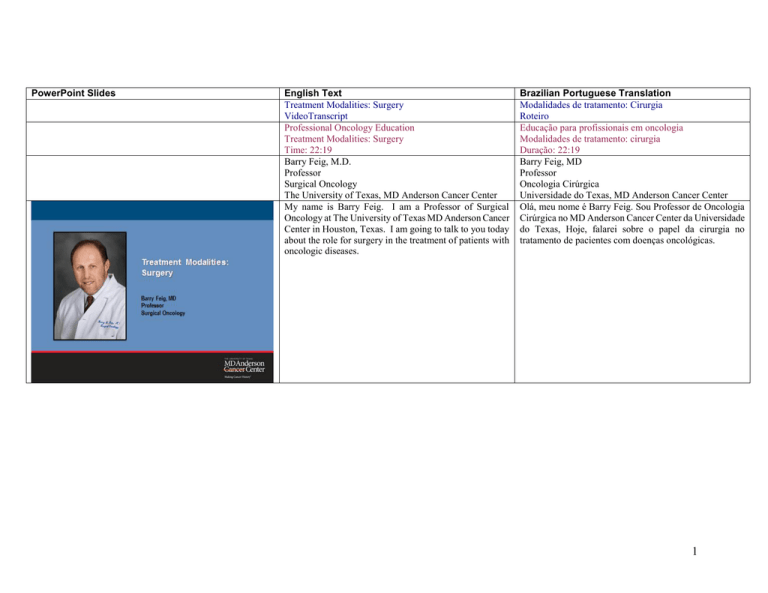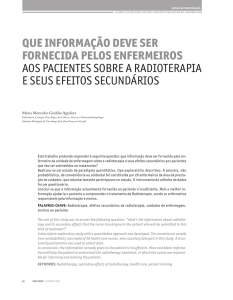
PowerPoint Slides
English Text
Treatment Modalities: Surgery
VideoTranscript
Professional Oncology Education
Treatment Modalities: Surgery
Time: 22:19
Barry Feig, M.D.
Professor
Surgical Oncology
The University of Texas, MD Anderson Cancer Center
My name is Barry Feig. I am a Professor of Surgical
Oncology at The University of Texas MD Anderson Cancer
Center in Houston, Texas. I am going to talk to you today
about the role for surgery in the treatment of patients with
oncologic diseases.
Brazilian Portuguese Translation
Modalidades de tratamento: Cirurgia
Roteiro
Educação para profissionais em oncologia
Modalidades de tratamento: cirurgia
Duração: 22:19
Barry Feig, MD
Professor
Oncologia Cirúrgica
Universidade do Texas, MD Anderson Cancer Center
Olá, meu nome é Barry Feig. Sou Professor de Oncologia
Cirúrgica no MD Anderson Cancer Center da Universidade
do Texas, Hoje, falarei sobre o papel da cirurgia no
tratamento de pacientes com doenças oncológicas.
1
The objectives of this session [are] to be able to discuss the
role for surgery for both solid tumors and hematologic
malignancies; to describe the various biopsy techniques,
which are used including incisional biopsy, excisional
biopsy, open biopsy, core biopsy as well as fine needle
aspiration; and to discuss the complications of surgical
intervention as well as the role for surgery in palliation and
in patients with metastatic disease.
Os objetivos da presente sessão [são] poder discutir o papel
da cirurgia para tumores sólidos e neoplasias malignas
hematológicas; descrever as diversas técnicas de biópsia,
que são utilizadas, incluindo a biópsia incisional, biópsia
excisional, biópsia aberta, biópsia do núcleo, bem como
aspiração por agulha fina, e discutir as complicações da
intervenção cirúrgica e também o papel da cirurgia no
tratamento paliativo e em pacientes com doença
metastática.
So, traditionally surgery is the main modality for treatment
of patients with solid tumors. It can be used both as a
diagnostic means, a curative means and a palliative means,
and we will discuss all those individually.
For
hematological malignancies, surgery is not traditionally a
curative modality. It is more of a supportive modality.
Surgery is used for venous access, not infrequently for
decreasing the burden of disease by doing splenectomies in
patients with leukemia or lymphoma, as well as doing
biopsies in order to obtain diagnoses for patients with these
disease processes.
Assim, tradicionalmente, a cirurgia é a modalidade
principal para tratamento de pacientes com tumores sólidos.
Ela pode ser usada como meio de diagnóstico, um meio de
cura e um meio paliativo, e discutiremos cada uma destas
possibilidades. Para doenças hematológicas malignas, a
cirurgia não é tradicionalmente uma modalidade curativa. É
mais uma modalidade de apoio. A cirurgia é usada para
acesso venoso, não raramente para diminuir a incidência da
doença, realizando esplenectomias em pacientes com
leucemia ou linfoma, bem como fazer biópsias para a
obtenção de diagnósticos para os pacientes com esses
processos de doença.
2
So, from a diagnostic standpoint, traditionally surgical
biopsy was done by either incisional or excisional biopsy.
Nowadays, open biopsies like incisional or excisional
biopsy are much less common. We much more commonly
use fine needle aspiration or FNA, core biopsies, or imageguided needle biopsies.
Assim, do ponto de vista de diagnóstico, a biópsia cirúrgica
foi tradicionalmente realizada tanto pela biópsia incisional
quanto excisional. Hoje em dia, as biópsias abertas, como a
biópsia incisional ou excisional, são muito menos comuns.
O mais comum é usar punção aspirativa por agulha fina ou
PAAF, biópsias de núcleo ou biópsias com agulha guiadas
por imagem.
Surgery has also traditionally been an important part of
staging the patient. Laparoscopic staging was initially a --was an initial use of laparoscopy in patients with cancer,
most commonly in patients with gastric cancer or pancreatic
cancer. However, as imaging modalities like CT scan, PET
scan, and MRI have markedly improved over the last
several years the use for --- the need for surgery in staging
has decreased. And it is fairly uncommon that we do
staging even using laparoscopic methods in patients with
cancer nowadays.
A cirurgia também tem sido tradicionalmente uma parte
importante da preparação do paciente. Inicialmente, o
estadiamento laparoscópico foi um --- foi um uso inicial da
laparoscopia em pacientes com câncer, em geral em
pacientes com câncer gástrico ou câncer de pâncreas. No
entanto, uma vez que modalidades de imagem como
tomografia, PET e RM têm melhorado muito ao longo dos
últimos anos o uso de --- a necessidade de cirurgia no
estadiamento diminuiu. Atualmente, é bastante incomum
realizarmos estadiamento usando métodos laparoscópicos
em pacientes portadores de câncer.
3
So, again the main purpose for surgery in patients with
solid tumors is curative treatment. Most patients --- even
patients understand that the best way to cure a tumor is to
take it out. It is the only treatment modality that
independently is able to provide cure for a large variety of
solid tumors. The basic principles of surgical resection for
cancer include the removal of all of the gross visible tumor.
And this should be done with surrounding margin of normal
tissue with a general rule of 2 cm being the accepted or the
ideal amount of normal tissue around the tumor that we
would like. In order to get that normal tissue around the
tumor, it may require resection of adjacent organs.
Então, mais uma vez, o principal objetivo para a cirurgia
em pacientes com tumores sólidos é o tratamento curativo.
A maioria dos pacientes --- mesmo os pacientes entendem
que a melhor maneira de curar um tumor é retirá-lo. É a
única modalidade de tratamento que, de forma
independente, é capaz de proporcionar cura para uma
grande variedade de tumores sólidos. Os princípios básicos
da ressecção cirúrgica do câncer incluem a remoção de todo
o tumor bruto visível. E isso deve ser feito ao redor da
margem de tecido normal com uma regra geral de 2 cm
como a quantidade aceita ou ideal de tecido normal ao redor
do tumor que gostaríamos. Para obter o tecido normal ao
redor do tumor pode ser preciso fazer a ressecção de órgãos
adjacentes.
Not infrequently we have to evaluate margins at the time of
surgery to be sure that not only all the macroscopic tumor is
removed, but the microscopic tumor as well. We fairly
liberally use intraoperative assessment, but depending --but there are some restrictions that may help guide whether
to use intra-operative assessment, because it is time
consuming and expensive. An intra-operative assessment is
not going to be helpful if there is no more tissue that can be
taken to improve the margin or if that additional tissue
would cause --- would inflict significant morbidity or
potentially even mortality on the patient. So if you can’t
get any more margin, there is no reason to assess the
margin. If you can get more tissue, then it makes sense to
assess the margin while the patient is still asleep and in the
operating room.
Não raro temos de avaliar as margens no momento da
cirurgia para ter certeza de que não só todo o tumor
macroscópico é removido, mas o tumor microscópico
também. Usamos avaliação intraoperatória de maneira bem
liberal, mas dependendo --- mas existem algumas restrições
que podem ajudar a guiar a possibilidade de uso da
avaliação intraoperatória porque é demorada e cara. Uma
avaliação intraoperatória não será útil se não houver mais
tecido que possa ser retirado para melhorar a margem ou se
o tecido adicional causar --- infligir uma morbidade
significativa ou mesmo até mortalidade no paciente. Então,
se você não puder obter uma margem maior, não haverá
razão para avaliar a margem. Se você puder obter mais
tecido, fará sentido avaliar a margem enquanto o paciente
ainda está anestesiado e na sala de cirurgia.
4
The immediate pathologic evaluation may be required to be
sure that the margin is free of tumor, and I think the most
frequent setting we use this in is breast cancer, because, if
we are doing a partial mastectomy, there is many times that
we can take more tissue to be sure that there is a true
microscopic negative margin. This can be difficult for the
pathologist, because, if patients have gotten preoperative
treatment either chemotherapy or radiation therapy, it can
be much more difficult for them to be able to evaluate
normal tissue from scar tissue from tumor tissue.
Additionally, if patients have had previous surgeries, scar
tissue can make frozen section more difficult to evaluate.
So, it’s not always easy for the pathologist to evaluate
margins while the patient is asleep. Again, it can be very
time consuming and also very expensive.
A avaliação patológica imediata pode ser necessária para se
ter certeza de que a margem está livre de tumor; eu acho
que o cenário mais frequente em que usamos é em câncer
de mama, porque, se formos fazer uma mastectomia parcial,
muitas vezes poderemos retirar mais tecido para ter certeza
de que há uma margem microscópica negativa verdadeira.
Isso pode ser difícil para o patologista, pois, se os pacientes
tiveram tratamento pré-operatório ou quimioterapia ou
radioterapia, poderá ser muito mais difícil para que ele
possa avaliar o tecido normal em relação ao tecido de
cicatrização do tecido tumoral. Além disso, se os pacientes
passaram anteriormente por cirurgias, o tecido cicatrizado
pode dificultar o exame por congelação. Então, nem sempre
é fácil para o patologista avaliar as margens enquanto o
paciente está anestesiado. Novamente, pode ser muito
demorado e também muito caro.
The other important role for surgery, which falls into
staging, is evaluation of the lymph node basins. That
frequently is required as I said for staging, but sometimes is
required for local control and in some cases even for cure of
the patient when removing lymph nodes will improve the
outcome. For intra-abdominal tumors like the stomach, the
colon, or the pancreas, the normal resection falls along
according to the vascular supply and drainage of that organ.
O outro papel importante para a cirurgia, que se enquadra
no estadiamento, é a avaliação das cadeias dos linfonodos.
Muitas vezes é necessária, como eu disse, para o
estadiamento, mas às vezes é necessário para o controle
local e, em alguns casos, até mesmo para a cura do paciente
quando a remoção dos gânglios linfáticos melhora o
resultado. Para tumores intra-abdominais, como do
estômago, do cólon ou do pâncreas, a ressecção ocorre na
sequência de acordo com o suprimento vascular e a
drenagem daquele órgão.
5
For trunk or extremities, tumors in the trunk or extremities
like, for example, the breast, there is an orderly drainage
pattern, as you see here, from the area of the tumor to the
lymph node basin.
Quanto ao tronco e extremidades, tumores no tronco ou nas
extremidades, como por exemplo, o de mama, há um
padrão de drenagem organizada, como você vê aqui, desde
a área do tumor até a cadeia do linfonodo.
It is very frequent that these tumors will spread through the
regional lymph nodes like in breast and melanoma. But
there are some tumors that never --- very rarely metastasize
to the lymph nodes, such as sarcoma and hepatocellular
carcinoma and those tumors, because they rarely, so rarely
metastasize to the lymph nodes, do not require a lymph
node evaluation.
É muito frequente estes tumores se espalharem através dos
gânglios linfáticos regionais, como no de mama e
melanoma. Mas existem alguns tumores que nunca --muito raramente entram em metástase para os gânglios
linfáticos, como sarcoma e carcinoma hepatocelular e
aqueles tumores, porque eles raramente, muito raramente
entram em metástase nos gânglios linfáticos, não exigem
uma avaliação dos linfonodos.
6
How else can we evaluate lymph nodes if we know there
are abnormal lymph nodes preoperatively? You can do a
fine needle aspiration. You can do a core biopsy. You can
do an excisional biopsy of the lymph node. You can do
lymphatic mapping and sentinel lymph node biopsy, or you
can do a formal lymph node dissection, and we will talk
about each of these individually.
De que outra forma podemos avaliar os gânglios linfáticos
se sabemos que há gânglios linfáticos anormais no préoperatório? Você pode fazer uma aspiração com agulha
fina. Você pode fazer uma biópsia do núcleo. Você pode
fazer uma biópsia excisional do linfonodo. Você pode fazer
o mapeamento linfático e biópsia do linfonodo sentinela ou
pode fazer uma dissecação formal do linfonodo; falaremos
sobre cada um destes.
So, fine needle aspiration is appropriate for evaluating
abnormal appearing lymph nodes that are either present on
physical exam, ultrasound, or other imaging methods. The
problem with fine needle aspiration is it gives you only
individual cells. So it can’t tell you anything about the
structure of the organ or whether there is invasion or not. It
can help you to rule out metastatic disease. One other
problem is that often you do not have adequate amount of
tissue for a complete pathologic evaluation of patients that
have hematologic malignancies, so you may be able to get a
preliminary evaluation, but not enough information to be
able to do a definitive treatment plan. Again, it may not be
enough tissue, because you are only getting individual cells,
to get a complete histologic diagnosis.
Assim, a aspiração com agulha fina é apropriada para
avaliação anormal dos gânglios linfáticos que estão
presente no exame físico, ultrassom ou outros métodos de
imagem. O problema com a aspiração com agulha fina é
que ela lhe dá apenas as células individuais. Por isso, não é
possível dizer nada sobre a estrutura do órgão ou se há
invasão ou não. Pode ajudar você a descartar uma doença
metastática. Outro problema é que, muitas vezes, você não
tem uma quantidade adequada de tecido para uma avaliação
patológica completa de pacientes portadores de doenças
hematológicas malignas, então você pode obter uma
avaliação preliminar, mas sem informação suficiente para
poder elaborar um plano de tratamento definitivo. Mais
uma vez, pode não haver tecido suficiente, porque você
apenas coleta células individuais para obter um diagnóstico
histológico completo.
7
An excisional biopsy provides more tissue for pathologic
evaluation. An excisional biopsy is a complete removal of
the gross tumor. It is helpful in cases that are difficult to
diagnose by needle biopsy, and for many hematologic
malignancies, it is necessary to have the complete structure
of the lymph node, for example, to be able to get a full
pathologic evaluation.
Uma biópsia excisional oferece mais tecido para avaliação
patológica. Uma biópsia excisional é uma remoção
completa do tumor bruto. É útil em casos que são difíceis
de diagnosticar por biópsia com agulha e, para muitas
doenças hematológicas malignas, é necessário ter a
estrutura completa do linfonodo, por exemplo, para se obter
uma avaliação patológica completa.
Lymphatic mapping and sentinel node biopsy is a procedure
that now has been in practice for about 10 years. It is based
on the fact that there is a reproducible orderly drainage of
lymphatics in almost all cases from the primary tumor.
And the first lymph node in that regional chain is called the
sentinel lymph node. Because of this orderly drainage, the
sentinel lymph node is that tumor --- that lymph node that is
most likely to harbor metastatic tumor cells.
O mapeamento linfático e a biópsia do linfonodo sentinela é
um procedimento que está em uso há aproximadamente 10
anos. Tem por base o fato de que há uma drenagem
reproduzível e ordenada dos vasos linfáticos em quase
todos os casos do tumor primário. E o primeiro linfonodo
naquela cadeia regional é chamado linfonodo sentinela.
Devido a esta drenagem ordenada, o linfonodo sentinela é
aquele tumor --- aquele linfonodo com mais probabilidade
para abrigar as células tumorais metastáticas.
8
It was originally described for patients with carcinoma of
the penis, but has really become the standard of care for
melanoma and invasive breast cancer. It is an extremely
accurate staging tool. If there is no tumor in the sentinel
lymph node then there is no need to do further nodal
removal in those diseases. On the other hand, if there is a
tumor in the sentinel lymph node, then it may be necessary
to perform further evaluation of the remainder of the lymph
node basin.
Foi originalmente descrita em pacientes com carcinoma do
pênis, mas tornou-se realmente o padrão de tratamento para
melanoma e câncer da mama invasivo. É uma ferramenta de
estadiamento extremamente precisa. Se não houver um
tumor no linfonodo sentinela, então não haverá necessidade
de fazer outra remoção nodal naquelas doenças. Por outro
lado, se houver um tumor no linfonodo sentinela, então
poderá ser necessário realizar uma avaliação mais
aprofundada do restante da cadeia do linfonodo.
That evaluation will be done by a formal lymph node
dissection. And a lymph node dissection is removal of the
majority of a lymph node basin. There are several purposes
to a lymph node dissection. It provides local control for
patients with --- that have metastases that have been
documented in the sentinel lymph node. It gives more
accurate staging, so you know the number of lymph nodes
that are involved when --- or if a sentinel node biopsy does
not work. There are times about 10% of --- less than 10%
of the time that sentinel lymph node biopsy is not
successful, where you cannot find the sentinel lymph node.
So, you may need to do a lymph node dissection in order to
be able to get an accurate lymph node evaluation. The
difference between a sentinel lymph node biopsy and a
lymph node --- a formal lymph node dissection is that there
is a significant increase in the morbidity in post-op recovery
with a formal lymph node dissection. The recovery is
significantly longer and more morbid.
Aquela avaliação será feita por uma dissecção formal de
linfonodos. E uma dissecção dos linfonodos é a remoção da
maioria de uma cadeia linfonodal. Existem diversas
finalidades para uma dissecação do linfonodo. Ela oferece
controle local em pacientes com --- que apresentam
metástases que foram documentadas no linfonodo sentinela.
Isto fornece um estadiamento mais preciso e, portanto, você
sabe o número de gânglios linfáticos que estão envolvidos
quando --- ou se uma biópsia do linfonodo sentinela não
funciona. Às vezes, cerca de 10% --- menos de 10% das
vezes em que uma biópsia do linfonodo sentinela não é
bem-sucedida, onde você não consegue encontrar o
linfonodo sentinela. Assim, talvez você precise fazer uma
dissecção dos linfonodos para obter uma avaliação precisa
do linfonodo. A diferença entre uma biópsia do linfonodo
sentinela e um linfonodo --- uma dissecação formal de
linfonodo é que há um aumento significativo na morbidade
na recuperação pós-operatória de uma dissecção formal de
linfonodo. A recuperação é significativamente mais longa e
mais mórbida.
9
Another area that we use surgery is after patients have
received neoadjuvant treatment. Both chemotherapy and
radiation therapy are often used in the neoadjuvant setting,
sometimes even together. Initially, there was concern that
the use of surgery after neoadjuvant treatment would
increase morbidity and mortality, and in some cases that is
true, especially after neoadjuvant radiation therapy.
However, most studies have shown that, for the diseases
that we use neoadjuvant radiation therapy, that risk --- that
increase in morbidity is not prohibitive.
Outra área em que usamos a cirurgia é após os pacientes
receberem tratamento neoadjuvante. Quimioterapia e
radioterapia são muitas vezes utilizadas no cenário
neoadjuvante, às vezes até em conjunto. Inicialmente,
houve uma preocupação de que o uso da cirurgia após o
tratamento neoadjuvante aumentaria a morbidade e a
mortalidade e, em alguns casos isso é verdade,
principalmente após a radioterapia neoadjuvante. No
entanto, a maioria dos estudos têm demonstrado que, para
as doenças que usamos radioterapia neoadjuvante, que o
risco --- que o aumento na morbidade não é proibitivo.
The purpose of neoadjuvant treatment is to reduce the
tumor size and bulk. This tumor cytoreduction may allow
for some patients to go from being unresectable to
resectable. And we see that with chemoradiation for rectal
cancer; we see it for patients with metastatic colorectal
cancer to the liver, as two examples of diseases that, not
infrequently we see good responses to neoadjuvant
treatment and enough tumor cytoreduction to allow a
change in surgical strategy. It also can reduce the extent of
surgery, and this is a way that we increase organ
preservation. And again, very classically this has been
done in breast cancer. And it has allowed us to do breast
conservation in patients who have large tumors by giving
them pre-operative chemotherapy --- neoadjuvant
chemotherapy. We can reduce the size of tumors and allow
them to have partial mastectomies as opposed to total
mastectomies. Additionally, it has been very clearly shown
in a number of studies that we can increase the sphincter
preservation rate in rectal cancer with neoadjuvant
chemoradiation therapy, and that is solely because we
decrease the bulk of the tumor, which allows the surgery to
A finalidade do tratamento neoadjuvante é reduzir o
tamanho e o volume do tumor. Esta citorredução do tumor
pode permitir que alguns pacientes passem de irressecáveis
para ressecáveis. E vemos isso com a quimiorradioterapia
para câncer retal, vemos isso em pacientes com câncer
colorretal metastático para o fígado, como dois exemplos de
doenças em que, não raro vemos boas respostas ao
tratamento neoadjuvante e citorredução de tumor o
suficiente para permitir uma mudança na estratégia
cirúrgica. Ela também pode reduzir a extensão da cirurgia, e
esta é uma forma de aumentarmos a preservação dos
órgãos. E, mais uma vez, muito classicamente, isso foi feito
no câncer de mama e nos permitiu preservar a mama em
pacientes que apresentam tumores grandes, administrando
quimioterapia
pré-operatória
--quimioterapia
neoadjuvante. Podemos reduzir o tamanho dos tumores e
permitir a realização de mastectomias parciais em vez de
mastectomias radicais. Além disso, vários estudos
demonstraram que podemos aumentar a taxa de preservação
do esfíncter no câncer de reto com a terapia de
quimiorradioterapia neoadjuvante e isso é apenas porque
10
be a little easier and more readily accomplished in terms of
being able to save the sphincters.
Well, since we can make tumors smaller, the question often
arises does it make sense to debulk tumors and take out part
of tumors. In general, it is felt that tumor debulking is not
indicated. It is unlikely to alter patient outcome in any solid
tumor malignancy. And it is frequently associated with
significant morbidity and mortality, because it is hard to
define tissue planes when you are cutting through tumor or
you are only taking out parts of tumor.
The only disease where it has been shown to be beneficial
to do tumor debulking is in patients with pseudomyxoma
peritonei. In those patients, neoadjuvant --- I’m sorry,
tumor debulking has been shown in combination with
intraperitoneal chemotherapy to both prolong survival and
decrease ascites.
diminuímos o volume do tumor, o que permite que a
cirurgia seja um pouco mais fácil e realizada mais
rapidamente em termos de poder salvar os esfíncteres.
Bem, já que podemos diminuir os tumores, muitas vezes
surge a questão de que se faz sentido reduzir o volume dos
tumores e retirar parte dos tumores. Em geral, considera-se
que a redução do volume do tumor não é indicada. É pouco
provável que possamos alterar o desfecho do paciente em
qualquer caso de tumor maligno sólido. E é frequentemente
associado à morbidade e mortalidade significativas porque
é difícil definir planos de tecido quando você corta o tumor
ou apenas retira partes do tumor.
A única doença em que a redução do volume do tumor se
mostrou benéfica foi para pacientes com pseudomixoma
peritoneal. Nestes pacientes, neoadjuvante --- desculpe,
demonstrou-se que a redução do volume do tumor em
combinação com quimioterapia intraperitoneal prolongou a
sobrevida e diminuiu a ascite.
11
There have been questions about the role for tumor
debulking in ovarian cancer and carcinomatosis. In ovarian
cancer, it is the other disease that has been really frequently
evaluated, the role and the benefit of debulking surgery and
intraperitoneal chemotherapy in ovarian cancer really
remains controversial at this time. In patients with
multifocal sarcomas throughout the abdominal cavity, so
called sarcomatosis, there really has been no proven role of
benefit in those patients to debulking tumors. In patients
with carcinomatosis, for example, from gastric cancer and
pancreatic cancer as well as colorectal cancer, again there
has been no good proven role or benefit for debulking those
patients and/or using intraperitoneal chemotherapy.
Houve perguntas sobre o papel da redução do volume do
tumor no câncer de ovário e na carcinomatose. No câncer
de ovário, esta é outra doença em que se tem avaliado
frequentemente, o papel e os benefícios da cirurgia de
redução de volume de tumor e quimioterapia intraperitoneal
no câncer de ovário realmente continuam controversos. Em
pacientes com sarcomas multifocais em toda a cavidade
abdominal, a chamada sarcomatose, não houve
comprovação do benefício do papel da redução de volume
de tumor para tais pacientes. Em pacientes com
carcinomatose, por exemplo, de câncer de estômago e
câncer de pâncreas, assim como câncer colorretal,
novamente não houve bom papel ou benefício comprovado
para a redução de volume do tumor para estes pacientes
e/ou o uso de quimioterapia intraperitoneal.
Another important role for surgery is the palliation of
patients with cancer. We really feel pretty strongly that
surgical treatment should be reserved for the alleviation of
symptoms. Reducing the bulk of tumor does not improve
outcome or increase survival. So, the surgical dogma is you
can’t palliate something if there is nothing to palliate. So, if
the patient is asymptomatic, you cannot improve that. You
can only improve on somebody --- a patient’s symptoms.
So, if there are no symptoms, you can’t palliate them. It is
probably one of the most difficult decisions to make in
surgery, deciding whether the benefit of intervening
palliatively from a surgical standpoint outweighs the cost
and benefit of an invasive procedure. You have to take into
account, there’s pain that you introduce from a surgical
procedure. Most likely, they will require a hospitalization.
And the worse scenario is, if a patient develops a
complication when you are doing palliation and has the
ultimate worse outcome, even a death. So, though all of
those are very difficult things to measure and predict,
making it much more difficult --- making it a much more
difficult decision as to when to do palliative surgery.
Outro papel importante para a cirurgia é o tratamento
paliativo de pacientes com câncer. Realmente acreditamos
que o tratamento cirúrgico deve ser reservado para o alívio
dos sintomas. Reduzir o volume de tumor não melhora o
resultado nem aumenta a sobrevida. Assim, o dogma
cirúrgico é que você não pode aliviar alguma coisa se não
há nada para aliviar. Portanto, se o paciente é assintomático,
você não pode melhorar isso. Você só poderá melhorar os -- sintomas de um paciente. Então, se não houver sintomas,
você não poderá atenuá-los. É provavelmente uma das
decisões mais difíceis de se tomar em cirurgia: decidir se o
benefício de intervir paliativamente do ponto de vista
cirúrgico supera o custo e o benefício de um procedimento
invasivo. Você deve considerar, você introduz dor com um
procedimento cirúrgico. Muito provavelmente, a
hospitalização será necessária. E o pior cenário é, se um
paciente desenvolver uma complicação quando você estiver
fazendo tratamento paliativo e acabar com o pior resultado
final, até mesmo a morte. Assim, embora tudo isto seja
muito difícil de medir e prever, torna ainda muito mais
difícil --- tomar uma decisão muito mais difícil quanto ao
12
Again, alleviating symptoms is the main role for palliation,
and we feel strongly that we should use the least invasive
methods possible to be able to alleviate those symptoms.
So, for example, if you can do something endoscopically, it
is better than doing something even laparoscopically, which
is better than doing something with open surgery. The least
surgery the better. So, for example, if a patient has an
obstructing colon cancer, a stent placed endoscopically may
relieve the obstruction and avoid a laparotomy or
laparostomy or avoid a colostomy. Most patients would
prefer not to have a colostomy bag even if they know it’s
terminal --- you know, part of their terminal event. It is
very a difficult thing to convince a patient that a colostomy
bag would be in their benefit. If patients are having pain,
sometimes things like nerve blocks or regional anesthesia
can be used for local control as opposed to resecting the
tumor. Again, if you are not going to change the survival,
putting a patient through a large operation that could have a
large morbidity due to blood loss, functional debility, etc.,
would not be as big a benefit as if you could control the
pain with either pain medication, nerve block, regional
anesthesia, or some other less invasive procedure.
Frequently, we are asked to help patients who have
blockages of their intestinal tracts by placing gastrotomy
tubes or feeding jejunostomy tubes. If those tubes can be
placed percutaneously, either by endoscopic techniques or
interventional radiology --- radiologic techniques, that’s
better than having the patient have to have an open
laparotomy, which again requires more anesthetic time,
possibly a hospitalization and the risk of more --- higher
risk of complications. We have to understand that
sometimes the best intervention may be no intervention. It
may be that doing nothing may be the best thing in the
palliative setting.
momento de realizar a cirurgia paliativa.
Novamente, aliviar os sintomas é o principal papel do
tratamento paliativo e acreditamos que devemos usar
métodos menos invasivos para aliviar estes sintomas.
Assim, por exemplo, se você puder fazer algo por via
endoscópica, é melhor do que fazer algo mesmo por
laparoscopia, que é melhor do que cirurgia aberta. Quanto
menos cirurgia, melhor. Assim, por exemplo, se um
paciente tiver um câncer de cólon com obstrução, um stent
colocado por endoscopia pode aliviar a obstrução e evitar
uma laparotomia ou laparostomia ou evitar uma colostomia.
A maioria dos pacientes prefere não ter uma bolsa de
colostomia, mesmo que saibam estar em estágio terminal --você sabe, parte do seu evento terminal. É muito difícil
convencer um paciente de que uma bolsa de colostomia
seria para o seu benefício. Se os pacientes sentem dor, às
vezes, coisas como bloqueio de nervos ou anestesia
regional podem ser usadas para o controle local ao invés da
ressecção do tumor. Novamente, se você não for mudar a
sobrevida, expor um paciente a uma operação de grande
porte que poderia ter grande morbidade devido à perda de
sangue, debilidade funcional, etc., não seria tão benéfico
quanto poder controlar a dor com qualquer analgésico,
bloqueio do nervo, anestesia regional ou algum outro
procedimento menos invasivo. Frequentemente, precisamos
ajudar os pacientes com obstrução no trato intestinal,
colocando tubos de gastrostomia ou tubos de jejunostomia
para alimentação. Se estes tubos podem ser colocados por
via percutânea ou por técnicas endoscópicas ou radiologia
intervencionista --- técnicas radiológicas, é melhor do que
fazer o paciente passar por uma laparotomia aberta, o que
novamente requer mais tempo de anestesia, possivelmente
uma internação e o risco de mais - - maior risco de
complicações. Temos que entender que, às vezes, a melhor
intervenção pode ser nenhuma intervenção. Pode ser que
não fazer nada possa ser o melhor no cenário de paliativos.
13
Another frequent expanded role for surgery has been the
role for surgery in patients with metastatic disease. And
traditionally surgery was not felt to be indicated and
certainly was not the first line of treatment for patients with
metastatic disease, because it was felt that surgery alone,
once the tumor has spread from its primary site, was not
going to be curative. So why put a patient through a large,
potentially painful, difficult recovery if you are not going to
be curing the patient? And it was always felt that nonoperative treatment modalities should be considered before
doing an operative intervention. When patients have
multiple sites of disease, we really think that it is extremely
rare that surgery could be of benefit in those patients. So,
surgery should be limited to again palliation, as we already
discussed. So, for example, if somebody has a bowel
obstruction, relieving that bowel obstruction, surgery may
be the only way to do that. Patients with symptomatic brain
metastasis, again surgery might be the only, or the best
potential mechanism for treating those symptoms.
On the other hand, when the patients have isolated
metastatic disease, it is possible that a subset of those
patients can be cured by resecting the metastatic disease.
So, how do we know who to resect and who not to resect
when there is metastatic disease? There is no good
scientific data to say who should be resected and who
should not be resected. We think that, if there is a period of
stability or response while the patient is on systemic
treatment, that might help predict who is going to benefit
from resection. So, again with metastatic disease the best
primary treatment is systemic treatment, chemotherapy or
biologic therapy. If we see a response or the stabilization of
tumor in those cases, then it may be that those patients have
a favorable biology and will benefit by taking out the tumor
then. So, some examples of situations where we use
selective surgery for isolated metastatic disease are in
Outro papel frequente ampliado para a cirurgia tem sido o
papel da cirurgia em pacientes com doença metastática. E,
tradicionalmente, não se considerou a cirurgia como
indicada e, certamente, não foi a primeira linha de
tratamento para pacientes com doença metastática porque
se considerou que a cirurgia em si, depois de o tumor ter-se
disseminado a partir do seu local principal, não seria
curativa. Então, por que colocar um paciente através de
uma recuperação difícil, grande, potencialmente dolorosa se
você não está curando o paciente? E sempre se acreditou
que as modalidades de tratamento não cirúrgico deviam ser
consideradas antes de se fazer uma intervenção cirúrgica.
Quando a doença se manifesta em vários locais no paciente
, realmente acreditamos ser extremamente raro que a
cirurgia possa ser vantajosa para estes pacientes. Assim, a
cirurgia deve ser limitada ao tratamento paliativo, como já
discutimos. Assim, por exemplo, se alguém tiver uma
obstrução intestinal, a cirurgia pode ser a única solução para
aliviá-la. Para pacientes com metástases cerebrais
sintomáticas, novamente, a cirurgia pode ser o único ou o
melhor mecanismo para tratar estes sintomas.
Por outro lado, quando os pacientes apresentam doença
metastática isolada, é possível que um subconjunto dos
pacientes possa ser curado através da ressecção da doença
metastática. Então, como sabemos quem ressecar e quem
não ressecar quando há doença metastática? Não há bons
dados científicos para dizer quem deve ser ressecado e que
não deve ser ressecado. Pensamos que, se houver um
período de estabilidade ou de resposta, enquanto o paciente
estiver em tratamento sistêmico, isto pode ajudar a prever
quem se beneficiará da ressecção. Então, novamente, com
doença metastática, o melhor tratamento primário é o
tratamento sistêmico, quimioterapia ou terapia biológica. Se
virmos uma resposta ou a estabilização do tumor nestes
casos, então pode ser que os pacientes tenham uma biologia
favorável e que se beneficiem com a excisão do tumor.
Assim, alguns exemplos de situações em que usamos a
14
patients with sarcoma who we see respond to
chemotherapy. We might do resection of their lung
metastasis. One of the most common things that we see is
patients with colorectal cancer and liver metastasis. We
used to say that the limit for a liver resection was for
metastasis, and now we have kind of expanded that limit to
we don’t know what the upper limit should be. We think
that, if patients are responding and their tumors are
respectable, that they potentially could benefit from
resection. There have been several studies to show that
there is even a survival benefit in those --- that group of
patients. So, if you see a response, or even a stabilization,
because stabilization is a response, tumors don’t necessarily
just have to shrink. If the tumor stops growing that means
it has responded to the treatment. So, if there is some sign
of response to systemic treatment, resecting those tumors
may be reasonable. And, again, in patients with brain
metastasis for melanoma, another disease where we may be
able to show benefit in both survival and outcome in those
patients [is] by resecting that disease.
cirurgia seletiva para doença metastática isolada são os de
pacientes com sarcoma que respondem à quimioterapia.
Talvez possamos fazer a ressecção de sua metástase
pulmonar. Uma das coisas mais comuns que vemos são
pacientes com câncer colorretal e metástase hepática.
Costumávamos dizer que o limite de uma ressecção
hepática era a metástase, e, agora, expandimos aquele limite
pois não sabemos qual deve ser o limite superior. Pensamos
que, se os pacientes responderem e os tumores não forem
nada desprezíveis, eles possivelmente poderiam se
beneficiar da ressecção. Vários estudos mostram que há
ainda um benefício de sobrevida nesses grupos --- o grupo
de pacientes. Então, se você vir uma resposta, ou mesmo
uma estabilização, porque a estabilização é uma resposta, os
tumores não necessariamente precisam encolher. Se o
tumor parar de crescer, significa que respondeu ao
tratamento. Então, se houver algum sinal de resposta ao
tratamento sistêmico, pareceria razoável ressecar os
tumores. E, novamente, em pacientes com metástase
cerebral de melanoma, outra doença onde podemos mostrar
benefícios tanto na sobrevida quanto nos resultados nos
pacientes [é] através da ressecção da doença.
15
One issue that I have alluded to several times is that surgery
comes with potential downsides, and you can’t do surgery
without the potential of having complications. We really
define surgery --- surgical complications into acute and
chronic. Acute surgical complications are defined as those
that occur within 30 days of the operation. They could be
related to the anesthesia and the surgery, such as
pneumonia, urinary tract infections, or venous thrombosis
are some of the more common complications that we see in
the early postoperative period. They may be related to
surgery itself, like an abscess, a fistula, or bleeding. All of
these are problematic, delay recovery, and even more
significantly can potentially delay systemic or adjuvant
systemic treatment or radiation treatment.
Uma questão a que aludi várias vezes é que a cirurgia
apresenta desvantagens potenciais e não existem cirurgias
sem complicações. Realmente definimos cirurgia --- as
complicações cirúrgicas em agudas e crônicas. As
complicações cirúrgicas agudas ocorrem no prazo de 30
dias da operação. Elas poderiam estar relacionadas com a
anestesia e a cirurgia, como a pneumonia, as infecções do
trato urinário ou a trombose venosa que são algumas das
complicações mais comuns que vemos no início do período
pós-operatório. Elas podem estar relacionadas à cirurgia em
si, como um abcesso, fístula ou sangramento. Tudo isso é
problemático, retarda a recuperação e, ainda mais
importante, pode retardar o tratamento sistêmico ou
adjuvante sistêmico ou radioterapia.
Chronic complications are defined as those that occur or
continue for more than 30 days after surgery, and some of
the more common things we see are, for example,
lymphedema after a lymph node dissection in the extremity.
Not uncommonly we can see patients with pain syndromes
when there is neurologic involvement of a tumor that has
been resected. And then bowel and bladder dysfunction can
happen after pelvic surgery, not uncommonly. There is not
--- very frequently a change in bladder and bowel habits
after both bladder or rectal surgery, and those can be for the
patient’s entire lifetime, a different change in their bowel
patterns or urinary patterns.
As complicações crônicas ocorrem ou persistem por mais
de 30 dias após a cirurgia; o mais comum é vermos, por
exemplo, linfedema após a dissecção de linfonodos na
extremidade. Não raro podemos ver pacientes com
síndromes de dor quando há comprometimento neurológico
de um tumor que foi extirpado. E, depois, disfunção
intestinal e da bexiga podem acontecer após a cirurgia
pélvica, o que não é raro. Não há --- muito frequentemente,
uma mudança nos hábitos da bexiga e do intestino após
cirurgia da bexiga ou cirurgia retal e podem perdurar pela
vida do paciente, uma mudança diferente em seus padrões
intestinais ou urinários.
16
So, in summary, surgery plays an important role in both the
diagnosis, the staging, and the treatment of cancer, more so
in solid tumors but also an important role in hematologic
malignancies as well. In addition to rendering a patient
disease free from their tumor, surgery may be beneficial in
providing effective palliation for selected patients. Surgery
can result in both acute and chronic complications. I would
like to thank you for your time, and please do not hesitate to
contact us if there should be any questions regarding this
lecture. Thank you very much.
Assim, em resumo, a cirurgia desempenha um papel
importante no diagnóstico, estadiamento e tratamento do
câncer, ainda mais em tumores sólidos, mas também um
papel importante em doenças hematológicas malignas.
Além de livrar o paciente do tumor, a cirurgia pode ser
benéfica ao proporcionar eficácia paliativa para pacientes
selecionados. A cirurgia pode resultar em complicações
agudas e crônicas. Gostaria de agradecer a sua atenção e
não hesite em nos contatar se tiver alguma dúvida sobre
esta palestra. Muito obrigado.
17












